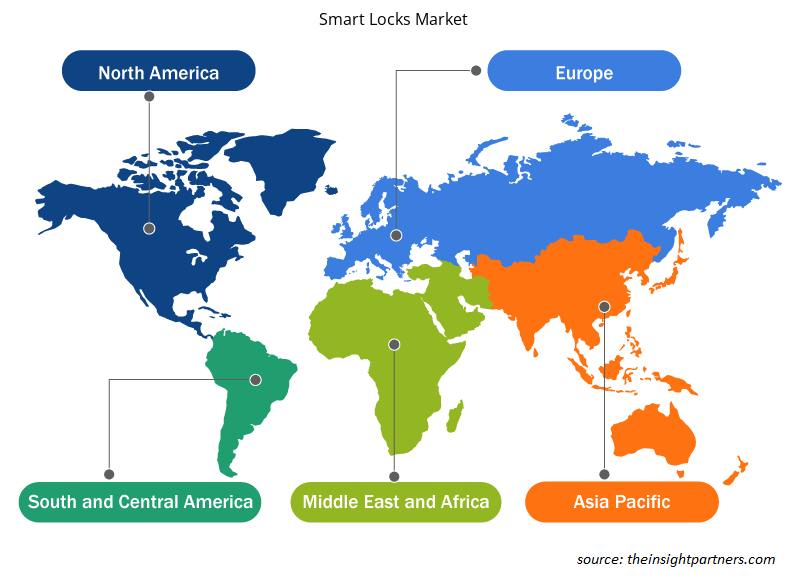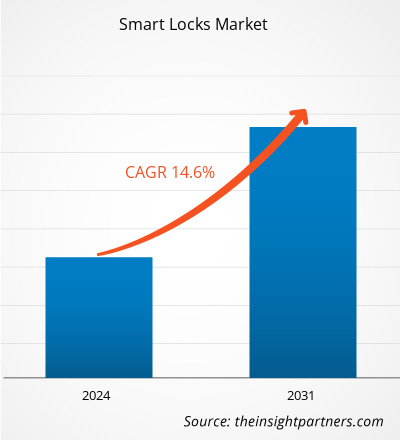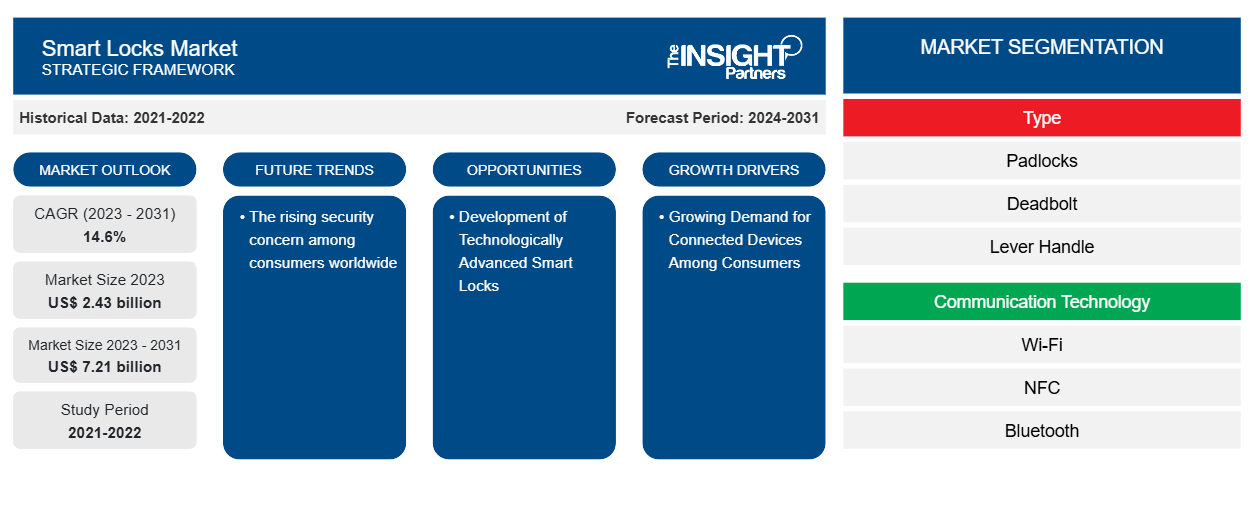Der Markt für intelligente Schlösser soll von 2,43 Milliarden US-Dollar im Jahr 2023 auf 7,21 Milliarden US-Dollar im Jahr 2031 anwachsen. Der Markt soll zwischen 2023 und 2031 eine durchschnittliche jährliche Wachstumsrate (CAGR) von 14,6 % verzeichnen. Das steigende Sicherheitsbedenken der Verbraucher weltweit dürfte ein wichtiger Markttrend für intelligente Schlösser bleiben.
Marktanalyse für intelligente Schlösser
Der Markt für intelligente Schlösser wächst rasant, da die Verbraucher zunehmend nach vernetzten Geräten verlangen, die Urbanisierung zunimmt und die Verbraucher zunehmend intelligente Geräte verwenden. Der Markt wächst stetig, da die Verbraucher zunehmend intelligente Schlösser mit erweiterten Funktionen gegenüber herkömmlichen Schlössern bevorzugen und Smart-City-Projekte an Bedeutung gewinnen. Darüber hinaus bieten die Entwicklung technologisch fortschrittlicher intelligenter Schlösser und die zunehmende Nutzung IoT-basierter Sicherheitsgeräte lukrative Möglichkeiten für Marktwachstum.
Marktübersicht für intelligente Schlösser
Ein Smart Lock ist ein Bluetooth- oder Wi-Fi-fähiges Smart-Home-Gerät, mit dem Benutzer Türen mit ihrem Finger oder einem einfachen Sprachbefehl öffnen und verriegeln können. Es ist eine fortschrittlichere Version des klassischen Schlosses. Das intelligente Türschloss wird nach der Authentifizierung per Fernzugriff durch einen kryptografischen Schlüssel aktiviert, sodass nur autorisiertes Personal Zugang erhält. Das Smart-Lock-System wird häufig in Wohn- und Geschäftsgebäuden eingesetzt, um durch verbesserte Benutzerfreundlichkeit einen neuartigen Ansatz für Schließsysteme zu bieten. Darüber hinaus bietet die Entwicklung fortschrittlicher Technologien wie KI, IoT, Big Data und Cloud-basierte Anwendungen erhebliche Wachstumschancen auf dem Markt für intelligente Türschlösser.
Passen Sie diesen Bericht Ihren Anforderungen an
Sie erhalten kostenlose Anpassungen an jedem Bericht, einschließlich Teilen dieses Berichts oder einer Analyse auf Länderebene, eines Excel-Datenpakets sowie tolle Angebote und Rabatte für Start-ups und Universitäten.
-
Holen Sie sich die wichtigsten Markttrends aus diesem Bericht.Dieses KOSTENLOSE Beispiel umfasst eine Datenanalyse von Markttrends bis hin zu Schätzungen und Prognosen.
Markttreiber und Chancen für intelligente Schlösser
Die wachsende Nachfrage der Verbraucher nach vernetzten Geräten treibt den Markt an
Die ständig steigende Nachfrage der Verbraucher nach vernetzten Geräten wie Tablets, Smartphones und anderen vernetzten Geräten treibt den Markt für intelligente Schlösser an. Diese Geräte können Daten empfangen und übertragen, die zur Steuerung intelligenter Schlösser verwendet werden. Intelligente Schlösser benötigen keinen physischen Schlüssel, und auf die virtuellen Schlüssel kann über Smartphones, tragbare Geräte und andere vernetzte Geräte zugegriffen werden. Daher beflügelt die Bedienbarkeit intelligenter Schlösser über Smartphones und vernetzte Geräte den Markt.
Entwicklung technologisch fortschrittlicher Smart Locks – eine Chance auf dem Markt für Smart Locks
Die Ausweitung von Smart-City-Projekten auf der ganzen Welt erhöht den Bedarf an intelligenten Geräten wie intelligenten Schlössern, um den Stadtbewohnern mehr Sicherheit zu bieten. Die Nachfrage der Verbraucher nach fortschrittlichen Smart-Home-Geräten wie intelligenten Türschlössern und intelligenten Alarmsystemen zur Verbesserung ihrer Sicherheit zu Hause schafft Chancen auf dem Markt. Große Branchenunternehmen, darunter August Home, ASSA ABLOY AB, DESSMANN, Godrej Group und andere, konzentrieren sich auf die Herstellung neuer Türschlossgeräte und -technologien für den privaten, gewerblichen und staatlichen Gebrauch. Diese Unternehmen erweitern ihr Produktangebot durch Geschäftstechniken wie Übernahmen, Fusionen und Partnerschaften. So übernahm ASSA ABLOY im Oktober 2022 die Bird Home Automation GmbH („DoorBird“), um sein Angebot an Smart-Home-Sicherheitslösungen zu erweitern.
Segmentierungsanalyse des Marktberichts für intelligente Schlösser
Wichtige Segmente, die zur Ableitung der Marktanalyse für intelligente Schlösser beigetragen haben, sind Typ, Streaming-Typ, Kommunikationstechnologie und Anwendung.
- Nach Typ ist der Markt für intelligente Schlösser in Vorhängeschlösser, Riegelschlösser, Hebelgriffschlösser und andere unterteilt. Das Segment Vorhängeschlösser hatte im Jahr 2023 einen größeren Marktanteil.
- In Bezug auf die Kommunikationstechnologie ist der Markt für intelligente Schlösser in Wi-Fi , NFC, Bluetooth und andere unterteilt. Das Wi-Fi-Segment hatte im Jahr 2023 einen größeren Marktanteil.
- Auf der Grundlage der Anwendung ist der Markt in Wohn-, Gewerbe- und Industrieimmobilien segmentiert. Das Wohnsegment hielt im Jahr 2023 den größten Marktanteil.
Marktanteilsanalyse für intelligente Schlösser nach Geografie
Der geografische Umfang des Marktberichts für intelligente Schlösser ist hauptsächlich in fünf Regionen unterteilt: Nordamerika, Asien-Pazifik, Europa, Naher Osten und Afrika sowie Südamerika/Süd- und Mittelamerika. In Bezug auf den Umsatz hatte Nordamerika aufgrund der zunehmenden Verbreitung von Smart-Home-Geräten bei den Verbrauchern den größten Marktanteil bei intelligenten Schlössern.
Der Markt im asiatisch-pazifischen Raum dürfte im Prognosezeitraum aufgrund zunehmender Smart-City-Projekte in Ländern wie China, Indien, Japan, Südkorea und anderen asiatischen Ländern mit einer deutlichen durchschnittlichen jährlichen Wachstumsrate wachsen. Die steigende Nachfrage und Akzeptanz fortschrittlicher Geräte bei den Verbrauchern ermutigt die Hersteller, neue Geräte zu entwickeln, die die Sicherheit zu Hause verbessern. So stellte Xiaomi im Dezember 2022 in China ein automatisches intelligentes Türschloss „E10“ vor. E10 ist das günstigste intelligente Türschloss mit NFC, einem Fingerabdruckscanner und einem Tastenfeld, das mehrere Möglichkeiten zum Aufschließen der Tür bietet. Der Fingerabdruckscanner in diesem intelligenten Türschloss kann über Bluetooth eine Verbindung herstellen und die Tür mit einem Smartphone oder einer Smartwatch öffnen.
Regionale Einblicke in den Markt für intelligente Schlösser
Die regionalen Trends und Faktoren, die den Markt für intelligente Schlösser im Prognosezeitraum beeinflussen, wurden von den Analysten von Insight Partners ausführlich erläutert. In diesem Abschnitt werden auch die Marktsegmente und die Geografie für intelligente Schlösser in Nordamerika, Europa, im asiatisch-pazifischen Raum, im Nahen Osten und Afrika sowie in Süd- und Mittelamerika erörtert.

- Holen Sie sich die regionalspezifischen Daten für den Markt für intelligente Schlösser
Umfang des Marktberichts zu intelligenten Schlössern
| Berichtsattribut | Details |
|---|---|
| Marktgröße im Jahr 2023 | 2,43 Milliarden US-Dollar |
| Marktgröße bis 2031 | 7,21 Milliarden US-Dollar |
| Globale CAGR (2023 - 2031) | 14,6 % |
| Historische Daten | 2021-2022 |
| Prognosezeitraum | 2024–2031 |
| Abgedeckte Segmente |
Nach Typ
|
| Abgedeckte Regionen und Länder |
Nordamerika
|
| Marktführer und wichtige Unternehmensprofile |
|
Marktteilnehmerdichte für intelligente Schlösser: Auswirkungen auf die Geschäftsdynamik verstehen
Der Markt für intelligente Schlösser wächst rasant. Dies wird durch die steigende Nachfrage der Endnutzer aufgrund von Faktoren wie sich entwickelnden Verbraucherpräferenzen, technologischen Fortschritten und einem größeren Bewusstsein für die Vorteile des Produkts vorangetrieben. Mit der steigenden Nachfrage erweitern Unternehmen ihr Angebot, entwickeln Innovationen, um die Bedürfnisse der Verbraucher zu erfüllen, und nutzen neue Trends, was das Marktwachstum weiter ankurbelt.
Die Marktteilnehmerdichte bezieht sich auf die Verteilung von Firmen oder Unternehmen, die in einem bestimmten Markt oder einer bestimmten Branche tätig sind. Sie gibt an, wie viele Wettbewerber (Marktteilnehmer) in einem bestimmten Marktraum im Verhältnis zu seiner Größe oder seinem gesamten Marktwert präsent sind.
Die wichtigsten auf dem Markt für intelligente Schlösser tätigen Unternehmen sind:
- HAVENLock
- Honeywell International Inc.
- August Home
- SAMSUNG
- Vivint, Inc.
- Wyze Labs, Inc.
Haftungsausschluss : Die oben aufgeführten Unternehmen sind nicht in einer bestimmten Reihenfolge aufgeführt.

- Überblick über die wichtigsten Akteure auf dem Markt für intelligente Schlösser
Marktnachrichten und aktuelle Entwicklungen zu intelligenten Schlössern
Der Markt für intelligente Schlösser wird durch die Erhebung qualitativer und quantitativer Daten nach Primär- und Sekundärforschung bewertet, die wichtige Unternehmensveröffentlichungen, Verbandsdaten und Datenbanken umfasst. Im Folgenden finden Sie eine Liste der Entwicklungen auf dem Markt für intelligente Schlösser und Strategien:
- Im März 2023 gab HavenLock, Inc. bekannt, dass es sein neues und innovatives Schließsystem beim US-Patent- und Markenamt (USPTO) patentieren ließ. (Quelle: HavenLock, Inc., Pressemitteilung, 2023)
- Im Februar 2023 gab SentriLock seine neue Partnerschaft mit der Chesapeake Bay & Rivers Association of REALTORS (CBRAR) bekannt, um SentriLock zur elektronischen Lockbox-Lösung des Verbands für seine REALTOR-Mitglieder zu machen. (Quelle: SentriLock, Pressemitteilung, 2023)
Marktbericht zu intelligenten Schlössern – Abdeckung und Ergebnisse
Der Bericht „Marktgröße und Prognose für intelligente Schlösser (2021–2031)“ bietet eine detaillierte Analyse des Marktes, die die folgenden Bereiche abdeckt:
- Marktgröße und Prognose auf globaler, regionaler und Länderebene für alle wichtigen Marktsegmente, die im Rahmen des Projekts abgedeckt sind
- Marktdynamik wie Treiber, Beschränkungen und wichtige Chancen
- Wichtige Zukunftstrends
- Detaillierte PEST/Porters Five Forces- und SWOT-Analyse
- Globale und regionale Marktanalyse mit wichtigen Markttrends, wichtigen Akteuren, Vorschriften und aktuellen Marktentwicklungen
- Branchenlandschaft und Wettbewerbsanalyse, einschließlich Marktkonzentration, Heatmap-Analyse, prominenten Akteuren und aktuellen Entwicklungen
- Detaillierte Firmenprofile
- Historische Analyse (2 Jahre), Basisjahr, Prognose (7 Jahre) mit CAGR
- PEST- und SWOT-Analyse
- Marktgröße Wert/Volumen – Global, Regional, Land
- Branchen- und Wettbewerbslandschaft
- Excel-Datensatz
Aktuelle Berichte
Verwandte Berichte
Erfahrungsberichte
Grund zum Kauf
- Fundierte Entscheidungsfindung
- Marktdynamik verstehen
- Wettbewerbsanalyse
- Kundeneinblicke
- Marktprognosen
- Risikominimierung
- Strategische Planung
- Investitionsbegründung
- Identifizierung neuer Märkte
- Verbesserung von Marketingstrategien
- Steigerung der Betriebseffizienz
- Anpassung an regulatorische Trends























 Kostenlose Probe anfordern für - Markt für intelligente Schlösser
Kostenlose Probe anfordern für - Markt für intelligente Schlösser